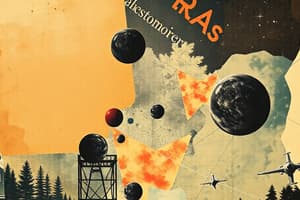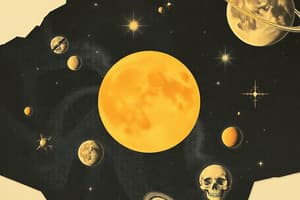Podcast
Questions and Answers
What type of planets are closest to the sun and have a rocky surface?
What type of planets are closest to the sun and have a rocky surface?
- Gas giants
- Dwarf planets
- Terrestrial planets (correct)
- Meteoroids
Which phenomenon explains the change of seasons on Earth?
Which phenomenon explains the change of seasons on Earth?
- Variation in solar activity
- Earth's proximity to the moon
- The distance from the sun
- Earth's tilt of 23.5 degrees (correct)
What is the primary reason for the tides on Earth?
What is the primary reason for the tides on Earth?
- The atmosphere's pressure changes
- The moon's gravitational pull (correct)
- The sun's gravitational pull
- Earth's rotation
What is the average distance between the sun and Earth known as?
What is the average distance between the sun and Earth known as?
What occurs when the moon's lit side faces away from Earth?
What occurs when the moon's lit side faces away from Earth?
Which is NOT a characteristic of gas giants?
Which is NOT a characteristic of gas giants?
How long does it take for Earth to complete one orbit around the sun?
How long does it take for Earth to complete one orbit around the sun?
What term describes a celestial object that orbits a star but does not dominate its orbit?
What term describes a celestial object that orbits a star but does not dominate its orbit?
What causes high tide in the ocean?
What causes high tide in the ocean?
What characterizes spring tides?
What characterizes spring tides?
What determines the luminosity of a star?
What determines the luminosity of a star?
What occurs when a large star exhausts its nuclear fuel?
What occurs when a large star exhausts its nuclear fuel?
Which of the following describes the Milky Way galaxy?
Which of the following describes the Milky Way galaxy?
What is a solar eclipse?
What is a solar eclipse?
What is one challenge of space travel related to astronaut health?
What is one challenge of space travel related to astronaut health?
What primarily causes the formation of galaxies after the Big Bang?
What primarily causes the formation of galaxies after the Big Bang?
What aspect of space probes is highlighted in the content?
What aspect of space probes is highlighted in the content?
Which of the following correctly defines a galaxy?
Which of the following correctly defines a galaxy?
How many days does it take for Earth to complete one rotation on its axis?
How many days does it take for Earth to complete one rotation on its axis?
Which statement accurately describes terrestrial planets?
Which statement accurately describes terrestrial planets?
What phenomenon occurs at both the summer and winter solstices?
What phenomenon occurs at both the summer and winter solstices?
What is a characteristic of comets?
What is a characteristic of comets?
What describes the asteroids found between the terrestrial planets and gas giants?
What describes the asteroids found between the terrestrial planets and gas giants?
Why do we experience different seasons on Earth?
Why do we experience different seasons on Earth?
What is the process called when the moon is fully illuminated as seen from Earth?
What is the process called when the moon is fully illuminated as seen from Earth?
What occurs during neap tides?
What occurs during neap tides?
What is the final stage in the life cycle of a massive star?
What is the final stage in the life cycle of a massive star?
How do artificial satellites benefit society?
How do artificial satellites benefit society?
Which of the following galaxies is categorized as a barred spiral galaxy?
Which of the following galaxies is categorized as a barred spiral galaxy?
What is one consequence of using rocket fuel during space travel?
What is one consequence of using rocket fuel during space travel?
What happens to a star with a mass over 30 times that of the sun at its end stage?
What happens to a star with a mass over 30 times that of the sun at its end stage?
Which type of telescope orbits the Earth for astronomical observations?
Which type of telescope orbits the Earth for astronomical observations?
What is the role of gravity in maintaining the orbit of satellites?
What is the role of gravity in maintaining the orbit of satellites?
What defines the concept of the Big Bang theory?
What defines the concept of the Big Bang theory?
Flashcards
Astronomy
Astronomy
The study of celestial objects and phenomena beyond Earth.
Planet
Planet
A large, round celestial object that orbits a star. Earth is a planet.
Star
Star
A massive collection of hot gas held together by its own gravity, emitting huge amounts of energy.
Astronomical Unit (AU)
Astronomical Unit (AU)
Signup and view all the flashcards
Galaxy
Galaxy
Signup and view all the flashcards
Orbit
Orbit
Signup and view all the flashcards
Tides
Tides
Signup and view all the flashcards
Lunar Cycle
Lunar Cycle
Signup and view all the flashcards
High Tide
High Tide
Signup and view all the flashcards
Low Tide
Low Tide
Signup and view all the flashcards
Spring Tide
Spring Tide
Signup and view all the flashcards
Neap Tide
Neap Tide
Signup and view all the flashcards
Luminosity
Luminosity
Signup and view all the flashcards
Light Year
Light Year
Signup and view all the flashcards
Nuclear Fusion
Nuclear Fusion
Signup and view all the flashcards
Main Sequence
Main Sequence
Signup and view all the flashcards
Nebula
Nebula
Signup and view all the flashcards
Big Bang
Big Bang
Signup and view all the flashcards
What causes high tides?
What causes high tides?
Signup and view all the flashcards
What is low tide?
What is low tide?
Signup and view all the flashcards
Describe spring tides.
Describe spring tides.
Signup and view all the flashcards
Describe neap tides.
Describe neap tides.
Signup and view all the flashcards
What is luminosity?
What is luminosity?
Signup and view all the flashcards
What is a light year?
What is a light year?
Signup and view all the flashcards
What is nuclear fusion?
What is nuclear fusion?
Signup and view all the flashcards
Describe a main sequence star.
Describe a main sequence star.
Signup and view all the flashcards
What is a nebula?
What is a nebula?
Signup and view all the flashcards
What is the Big Bang theory?
What is the Big Bang theory?
Signup and view all the flashcards
Study Notes
Unit 4: Space
- Astronomy: The study of celestial objects beyond Earth.
- Planet: A large, round celestial object orbiting a star. Humans and organisms live on Earth.
- Star: A massive collection of gases held together by gravity, emitting vast energy through electromagnetic radiation. The Sun is a star, producing energy via nuclear fusion in its core, providing us with heat and light.
- Solar System: The Sun and all the celestial objects orbiting it, including planets, asteroids, and comets.
- Terrestrial Planets: Rocky planets closest to the Sun (Mercury, Venus, Earth, and Mars).
- Gas Giants: Gaseous planets farthest from the Sun (Jupiter, Saturn, Uranus, and Neptune).
- Asteroid Belt: Region between terrestrial and gas giants containing asteroids (rocky/metallic celestial objects).
- Dwarf Planets: Celestial objects orbiting a star but not dominating their orbit (e.g., Pluto).
- Meteoroids: Smaller than asteroids, sometimes drawn to Earth by gravity.
- Comets: Chunks of ice/dust orbiting the sun in long paths.
- Astronomical Units (AU): The average distance between the Sun and Earth, a more convenient measure than kilometers.
- Galaxy: A huge rotating collection of gas, dust, stars, planets, and other celestial objects containing our Solar System; Earth is part of the Milky Way galaxy.
- Universe: Everything that exists, including all matter, energy, and galaxies.
Lesson 2: Earth's Motion and the Moon
- Orbit: A closed path of a celestial object moving around another. Earth orbits the Sun once every ~365.25 days, causing the seasons and leap years.
- Earth's Orbit: Earth completes an orbit around the Sun in 365.25 days, causing the seasons and leap years..
- Seasons: Earth's 23.5-degree axial tilt causes variations in sunlight reaching different hemispheres, resulting in seasons.
- Summer Solstice: Northern Hemisphere tilts most towards the sun, longest day.
- Winter Solstice: Northern Hemisphere tilts farthest from the Sun, shortest day.
- Equinoxes: Spring and Fall; equal day and night lengths (Vernal and Autumnal equinoxes).
- Earth's Rotation: Earth rotates once every 24 hours, creating day and night.
- Lunar Cycle: The Moon's apparent phases are due to the changing angles of sunlight reflecting from its surface.
- Full Moon: Moon's illuminated side faces Earth.
- New Moon: Moon's illuminated side completely faces away from Earth.
- Tides: Rise and fall of ocean levels caused by the Moon's gravity pulling on Earth's oceans:
- High Tide: The side closest to and opposite the Moon experience the strongest gravitational pull.
- Low Tide: The areas between high tides.
- Spring Tides: Occur at new and full moons when Sun and Moon align, causing higher-than-normal tides.
- Neap Tides: Occur at first and third quarter moons when Sun and Moon are perpendicular, resulting in lower-than-normal tides.
- Eclipses: When one celestial object blocks another.
- Solar Eclipse: Moon blocks sunlight from reaching Earth.
- Lunar Eclipse: Earth blocks sunlight from reaching the Moon.
- Satellites: Celestial objects orbiting a larger body.
- Artificial Satellites: Orbiting objects used for data collection, forecasting, and more; they do not crash due to the combination of their forward motion and the Earth's curve, which is counteracted by gravity's pull.
Chapter 9: Stars and Their Life Cycles
- Light-Years: Unit measuring distances in space.
- Star Brightness: Depends on a star's luminosity (energy output) and distance from Earth. Absolute magnitude compares stars' true brightness, considering distance.
- Star Color/Temperature: Color indicates surface temperature; blue stars are hottest, red stars are coolest.
- Star Composition: Spectrographs analyze light to determine elements.
- Star Mass: Affects a star's life cycle.
- Star Life Cycle:
- Nebula: A cloud of gas where stars form from a collapsing piece.
- Protostar: Precursor to a star.
- Main Sequence: Longest phase of a star's life, where nuclear fusion occurs in the core, producing energy, causing expansion.
- Small/Medium Mass Star: Consuming Hydrogen, expand into a red giant and then collapse to a white dwarf..
- Large Mass Star: Becomes a red supergiant, fuses heavier elements, explodes in a supernova, leaving behind a neutron star or black hole. Detailed descriptions for different conditions of mass are added.
Chapter 9, Lesson 2: Galaxies
- Galaxy Types: Spiral, barred spiral, lenticular, elliptical, and irregular.
- Milky Way: A barred spiral galaxy in the Local Group.
- Local Group: A cluster of galaxies.
- Virgo Supercluster: A larger collection of galaxy clusters containing the Local Group.
Chapter 10: Space Research and Exploration
- Space Exploration Methods:
- Telescopes: Ground-based and space-based (e.g., Hubble).
- Space Probes: Robotic vehicles investigating celestial objects.
- Spacecraft with Astronauts: Vehicles for human space travel
- Space Travel Challenges:
- Gravity: Rockets needed to launch and overcome Earth's gravity.
- Health Issues: Effects of microgravity and radiation on astronauts.
- Harmful environmental concerns: Rocket fuel causing ozone depletion.
- Space Junk: Unwanted objects in space, posing a threat to active satellites and spacecraft..
- Benefits of Space Travel: Scientific discoveries, improved technologies (e.g., consumer electronics), economic benefits, and improved applications in various fields.
Studying That Suits You
Use AI to generate personalized quizzes and flashcards to suit your learning preferences.




